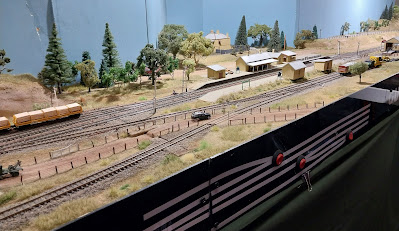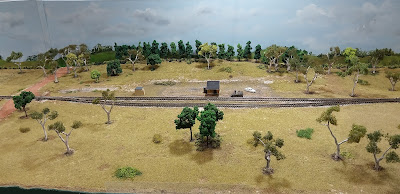The
Southern Aurora train
The
Southern Aurora was a first class premium sleeper only service, that ran
between Sydney and Melbourne. The
service started on April 16th, 1962, and due to various reasons, finished in August 1986.
The Aurora
was scheduled as an overnight train, running daily. One train headed north from Melbourne’s Swanson Street
station (now Southern Cross), and the southbound train left Sydney Central. They crossed generally north of Junee on the
double track.
Both trains
were not timetabled to stop at Wagga Wagga, so I never got to ride on
them. For Wagga passengers wanting an
overnight service, the railways provided the Spirit Of Progress, a train I got
to ride frequently in the late 1970s, and 1980
The
Southern Aurora was always diesel hauled.
 |
| PHN power van attached to train #66, (not the Southern Aurora), heading north, has just passed the Urana Street Level Crossing. Picture by Tony McIlwain Dec 13, 1961 |
 |
| Southtbound and late running Southern Aurora running extra late, and stopped as someone had dropped the staff which needed to be found. Sept 13th, 1962. Three pictures by Tony McIlwain |
Carriages
used.
Both NSW,
and Victoria co-operated on the building of the stainless steel carriages, which
are modified Pullman designs (for the loading gauge differences between
Australia, and USA) There were 7 main
designs
PHN Power
Van. 6 were built initially,
with one additional Power van in 1970 (after Violet Town accident destroyed PHN
2370)
MHN Parcel vans 3 were constructed
BCS Lounge
cars 3 were initially
constructed, with one replacement in 1970 to replace BCS 2355, destroyed in
Voilet Town accident in Feb 1969)
RMS Dining
cars 3 were constructed
DAM
sleeping car These are deluxe
twinnette. 2 were constructed
NAM
sleeping car Twinette. 9 were
constructed for the Aurora service, 2 as
late as 1971 to replace Voilet Town destroyed NAM 2339, and NAM 2343. (Note 5
additional NAMs were built from 1959, and used on the Brisbane Limited,
and 3 were used on the Spirit Of Progress)
LAN
sleeping car Roomette cars,
with a curving corridor. 11 constructed
– three in 1970 and 1971 to replace those destroyed at Voilet town (numbers
2345, 2346 & 2350). (Note 6 additional LAMs were built from 1959, and
used on the Brisbane Limited)
(Thanks to
Ian Black for much of the above information, the rest from Wiki)
When the
Southern Aurora train ceased, were the carriages scrapped?
Fortunately,
most of the carriage fleet was sold, or donated to various groups, and
museums. It is still possible to see,
and ride on them.
 |
| A preserved Southern Aurora passed through Wagga in 2012. (picture from the internet) |
Modelling
the Aurora carriages.
Ignoring
the earlier out of scale, and generic stainless steel corrugated carriages
produced by Triang/Hornby, Lima produced models of both the Indian Pacific, and
Southern Aurora sleeping cars in the 1970s.
The Southern Aurora cars were different from the Indian Pacific, in the
design of the sides, but otherwise they used the same roof, and carriage ends. These models were made in quantity, to go in their trainsets, along with NSW diesel
4469, or their horrid VR S variant,
which I will say no more). The carriage
was a fairly basic model, but a train of these did capture the feel of the
Aurora. However, being a basic model, the carriages were
lacking details. Casula Hobbies sold me
an underframe kit, which improved the look, by adding battery boxes, airtanks
and clutter. Replacement of the couplers
finished my improvements. Other simple
upgrades were replacement RP25/110 wheels/axle (to replace the Lima cookie
cutter wheels), and I undertand there was a flushglaze window kit.
 |
| Lima Aurora carriage, with underframe fitted. Similar to the NAM sleeper in the window style. The "railways of australia" decal is obviously a hangover from the Indian Pacific |
 |
| The underframe was a single piece of cast resin, glued or screwed to the base of the coach |
Modelling
the aurora train with Lima coaches was not that convincing for the purist, in
that Lima didn’t include the dining, lounge, or parcel vans. Lima later did introduce a power car for the
Indian Pacific, although that again used the same roof as the coaches, and none
of the exhaust openings. Both Hanovale
Models, and Hawksmoor produced kits for specific coaches for the Aurora. I bought the Hawksmoor PHN power van, but
have not assembled it
 |
| The Hawksmoor PHN kit included flush windows, bogies, and cost me $81. Being a resin casting, the sides have bowed slightly |
Some other
modellers went much further. Ian Black’s
series of Lima improvements, finally appeared in a series of articles starting
with issue 294 (June 2012) in the Australian Model Railway Magazine (AMRM) on
modifying the Lima cars to make up an entire Aurora train. For the dedicated kitbasher, these articles
are highly recommended for the techniques, and ideas employed. Ian has recently authored a small 36 page booklet on the aurora cars, available from the normal outlets. I don't have this book, but based on other modelling books Ian has authored, that I do have, it is recommended
In 2010,
TrainBuilder, a Victorian based company, sold a limited number of Aurora sets ,
made in China, RTR in brass. Their sets
of 7 coaches (DAM, NAM, LAN, PHN, BCS, RMS, & MHN) were priced at $3800, with individual extra
sleeping carriages around $550 each. I
am not aware if this set has been rerun
Then in
2016, Auscision brought out a 10 car Southern Aurora set, in RTR plastic for
$1400, (sets with an additional $100 for a period specific lit “Southern
Aurora” sign on the parcel van, and power cars were also available). These sets sold out quickly, and I was happy
to secure one set. Auscision’s rerun of these
sets in 2023, and at time of writing, are still available. Cost now $1500 ( or $1600
with the sign)
Neither the
Train Builder, or Auscision sets have been reviewed in AMRM. Thus an opportunity exists to do another
quick review
Picture
review of Train Builder Aurora set
I recently
was successful through an online auction of obtaining a Train Builder Southern
aurora 10 car set. On receipt of the
set, there were 2 RMS dining cars, and no MHN parcel van. The previous owner had also replaced the
brass Train Builder bogies, with Auscsion bogies for better running qualities. Trainbuilder have fitted lighting to all coaches, and a switch underneath can turn it on or off. This only works with the brass bogies (that I don't have). I didn't weigh the coaches, but they are more weighty than the Auscision set
Note. Click on an image for a bigger view. The pipework on these coaches is very impressive, and the thumbnail image doesn't do it justice
BCS Lounge Car by Trainbuilder
RMS dining car by Trainbuilder
.jpg) |
| The dining car was the only carriage in the Trainbuilder set that has an interior. |
Picture
review of Auscision Aurora set.
 |
| The Auscision box is impressive |
 |
| The coaches are neatly presented. Note. I have taken away the upper sheet of protective packing |
All the coaches, dining, and lounge car are fitted with full interiors. The blinds on the windows are particularly fine, and make it extremely hard to see inside the sleeping cars. The end diaphrams are flexible, and better than Train builders (in my opinion) Auscision have made the decision to not model the DAM sleeper. Auscision couplers are Kadee and designed for radius greater than 24". Alternate couplers are provided for tighter radius curves (if needed). End lighting for the PHN, and MHN end cars is provided, with a 21 pin DCC socket for specific control of these. Weight of the coaches is consistant between classes - being between 145 and 149 grams
Auscision BCS
Auscision PHN
Auscision RMS
Auscision LAM
Auscision NAM
Auscision MHN
Conclusion
Both TrainBuilder, and Auscision have done justice to this train. As you can see from my pictures, there is little to tell them apart. Once I add
the locos, the Southern Aurora will constitute quite an investment for a pair
of trains that on my layout will run from one staging yard, to the other,
without even stopping at Wagga Wagga. They say modellers can be crazy, but at
least I got to write them up in my blog, and share some really great prototype pictures, courtesy of Tony McIlwain.
Until next
time, build a model or two




.jpg)
.jpg)
.jpg)
.jpg)
.jpg)
.jpg)
.jpg)
.jpg)
.jpg)
.jpg)
.jpg)
.jpg)
.jpg)
.jpg)
.jpg)
.jpg)
.jpg)
.jpg)
.jpg)
.jpg)
.jpg)
.jpg)
.jpg)
.jpg)
.jpg)
.jpg)
.jpg)
.jpg)
.jpg)
.jpg)










































